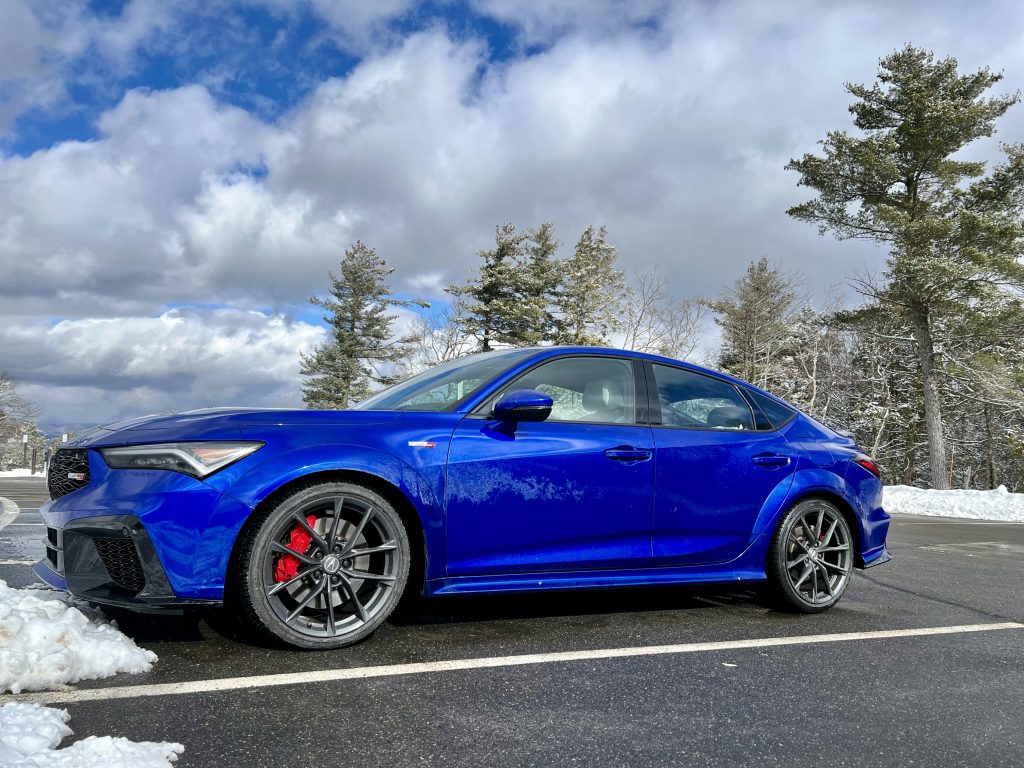New Cars We Love
Our periodic impressions of what’s hot, distinct, retro (for the better) and future-forward

We’re going to start giving you something a little different from time to time starting now, with periodic sound-bite impressions of the cars we’ve been testing lately. We’ll ping designers with questions about the cars they’re creating, as we always do, but we’re also going to nail what we think are overlooked highs, not just on design, but on overall usage and the hidden joys of certain vehicles. Here’s a look at some of what we’ve driven over the past few months.

Acura Integra Type S
The pro tip of the Acura Integra Type S runs something like this: It has a manual six-speed; they don’t even offer it in an automatic! This is true, and the gearbox is superb. In many ways it’s the equal of paddle shift gearboxes, no matter how much more precise they are for track use, because a third pedal allows a driver to mitigate power uptake, and paddles cannot do that. It’s why we love Miatas—and Alfa Romeo 124s from the late 1960s before that. It’s also light, so even if the BMW M2 is a full second faster to 60mph it’s also 600 pounds heavier. Sure the BMW is also a blast, but only at higher speeds, where the Integra Type S is big-goofy-grin fun around town.
The Acura has five more inches of rear-seat knee room than the BMW M2, as well as five more inches of hip room. Four adults fit. There’s nearly double the cargo capacity, too, thanks to a hatchback design. And there was clearly a driver-specific rethink to the car’s secondary controls. That means radio dial knobs for climate, and buttons for climate modes (rather than burying these in the display). The display itself has a very obvious logic, too. There’s just nada to gripe about, and considering Acura’s legendary quality, and the fact that this car is just a wee bit more refined than its Honda twin, the Civic Type R (and looks more grown up), we’ll vote Acura FTW.
Hyundai Santa Fe
Senior designer Brad Arnold gave us a walkaround of the retooled Hyundai Santa Fe during the New York Auto Show—and we drove the car shortly after. Arnold stressed that the more chiseled exterior was created by the company’s Korean team, not the American one, but “the Korean design studio, they captured what the US customer is looking for.” The sharper angles aren’t the only change: Arnold stressed pragmatic aspects to the rebooted Santa Fe, including a wider hatch area that’s specifically focused on tailgating (but would benefit any driver), “like you’re pulling a stroller out of the back, because the focus was how can we widen the hatch width and widen the opening better than any Hyundai or any other vehicle in the market?” Arnold said that led to the decision to lower the taillamps, which are now patterned in the form of a wide letter “H,” that are artfully blocky, reflecting the overall brick-like form of the six-passenger family rig.
Arnold is also proud of a hidden, recessed panel on the C-pillar that pops into the frame. This pocket folds in to create a grab handle so the owner can stand on the rear tire and hoist themselves up. “It’s so silly. We ended up in a lot of heated discussions about whether this was really that important and the answer was ‘yes.’ All these features are that important to creating an improved experience for families and anybody else that has this vehicle.” Stepping back, Arnold explained that Hyundai as a brand is confident that they can make a rugged, more off-road worthy Santa Fe and have it “boxier and robust, and then we can have things that are a lot sportier, and it doesn’t make sense to do a uniform design language or uniform architecture. For each product our customers are looking for something different.”
2024 AMG GLA 35 SUV
The GLA is an overlooked Mercedes-Benz that shouldn’t be. We’ve just driven the AMG version and it’s the “hot-hatch” nobody chatters about—but definitely should. Compared to a Hyundai Veloster N, Toyota GR Corolla, Honda Civic Si and even a Golf GTI, it’s the stealth option in a room full of braggarts. This isn’t to say the others don’t have fine attributes (hat tip to the Acura Integra Type S mentioned in this thread), because they do, and in a race, it’s probably the Toyota that spanks the Benz. But the cost is cars that are uncomfortable with their muscles and arrive with cabins that are way less refined. The Benz is a car you can live with. It’s funky if not gorgeous; it isn’t festooned with fins and downforce effects and is not painted in faux rally racing livery. It’s stable on the highway and practical in all the right ways, with a big hatch that’ll swallow weekender luggage or stow goodies after a trip to the garden center, hauling back bags of mulch and a few plants parked on the backseats.
Then, it envelopes you completely on curvy, swerve-y two-laners, where its AMG joys (like a quick-shifting paddle arrangement and 295hp) zap to life. Mercedes gets all the ingredients right. The cost, however, isn’t cheap: $56K and change pushes way above the other “adult” option: the Golf GTI, can be had for $20,000 less. Even if you’d argue that the proper competition is the AWD Golf R, that’s still ten grand less. So the Benz is a reach. But since when did anyone tout greatness, Mercedes and bargain basement in the same sentence?
Lexus TX550h PHEV
Lexus and its parent company, Toyota, have been telling the world that plug-in hybrids are where it’s at. We were at the Japan Mobility Show this past October, where Toyota officials were not only happy to show off concept EVs by the fistful but were also saying that the number one carmaker on earth (depending on how you count) would be a major player in EVs with groundbreaking product by about 2026. Back here in 2024, the TX550h is a plug-in hybrid, and as a group, no carmaker does this better. This seven-passenger beast is a good example. It offers a low step-in height and an incredibly serene ride—while being cosseted and deluxe but not showy inside.
You can drive the TX 39 miles in EV-only mode, which, if you plug it in nightly, might mean you never drive with gas. But at $76,700 it’s bumping up against EVs, and in particular KIA’s excellent EV9—see below—which can be had for a lot less money, also has three rows of seats and even though it has a big, heavy battery, weighs less than the hybrid Lexus.
KIA EV9
Let’s take a moment to compare the looks of the KIA EV9, which are very polarizing, to those of the aforementioned Lexus. If you know recent car design history you know that the once controversial Lexus visage has calmed down substantially. We think the EV9 design is fascinating; as for taking on the PHEV Lexus TX, the $69,900 Land version of the EV9 we tested was pretty loaded, with first and second-row heated and cooled seats.
All EV9s also get a lovely, futuristic flat-panel display that stretches seamlessly from the dash center through the driver’s gauges and includes configurable tiles, but is also aided via haptic mode switches and actual buttons for climate control. As for EV-ness, the AWD Land can go 280 miles between charges. Spend less ($59,200) on the Light Long Range and it’ll hit 304 miles. The rub, if there’s one, is that the third row of the EV9 is tight—between 29.9 and 32 inches, depending on spec. The Lexus musters 33.5 inches—and it bests the EV9 for maximum cargo, too. But drive both back to back and you feel the KIA’s relatively lighter 5,795 lbs versus the Lexus’s 6,540, and the dual electric powertrain’s instant torque. Plus, all of the KIA’s heft sits in the floor, so it corners better, too—and it’s quieter than the Lexus, too. We’d still understand buying the TX; it’s excellent, and massively spacious. But to us, the EV9 edges it out.













What are your thoughts?